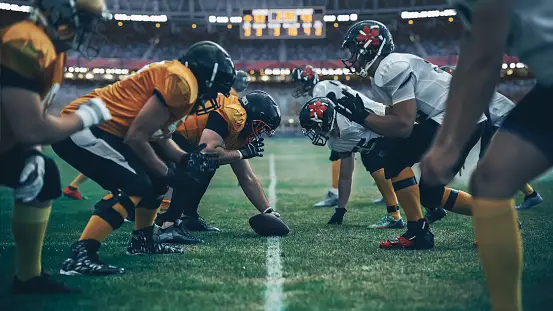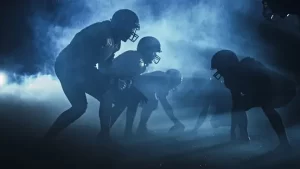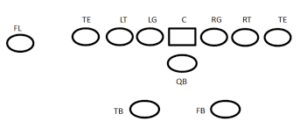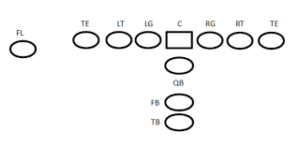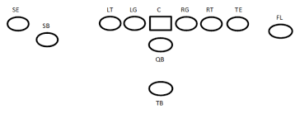In the dynamic world of American football, understanding various strategies and formations can significantly enhance one’s appreciation of the game. One crucial aspect of football that often goes overlooked is the concept of the weak side in football. This element plays a pivotal role in both offensive and defensive planning and can greatly influence the outcome of a match.
The weak side in football refers to the side of the field with fewer offensive players, typically opposite from where the tight end lines up. Generally seen as a vulnerable part of the formation, it not only influences the tactics of the offense but also greatly impacts the defense’s approach to counter the opposition’s plays. By delving into the weak side strategy, one can uncover insightful and fascinating details that unveil the complexity of the sport itself.
Contents
Weak Side Definition in Football
The weak side in football refers to the side of the field opposite the side that the tight end (TE), an offensive player, lines up on. It is called the “weak side” because there are generally fewer players on that side of the formation compared to the strong side The strong side includes the tight end. This distinction is important for both defensive and offensive strategies during a game.
In most cases, the weak side also corresponds to the side away from the majority of the offensive line’s players. This creates an asymmetry in the number of players on each side of the formation, with the strong side having more players and the weak side having less. The weak side provides opportunities for the offense and defense to exploit during a game as they adapt to changing circumstances on the field.
Defensive coordinators often design plays considering the weak side, focusing on creating coverage that anticipates or reacts to movements by the offense. By deploying their players in various positions, they aim to counter possible offensive maneuvers, such as passing play to a weak side receiver, which the offense may take advantage of to exploit fewer defenders in that area.
For Offense
On the offensive side, recognizing the weak side allows for strategic play development that can lead to unexpected gains or tactical advantages. For example, an offensive team may decide to run a play to the weak side, catching the defense off guard, particularly if the defense is focused on the strong side where the tight end is present.
While understanding the weak side in football is vital for both offensive and defensive strategies, it is also essential for players. Player need to remain flexible and able to respond to changes in the opponent’s formation during a game. The distinction between strong and weak sides can shift depending on various factors.
Significance of the Weak Side
Strategies and Formations
The weak side in football is the side of the field with fewer offensive players, usually the side without a tight end. This side plays a crucial role in developing offensive and defensive strategies.
Offensive coordinators design plays around the weak side to take advantage of fewer defenders by incorporating tactics such as:
- Utilizing weak side receivers in pass plays to exploit one-on-one matchups.
- Implementing weak side runs to make use of open space.
- Designing misdirection plays that focus on the strong side, only to shift to the weak side to fool the defense.
These strategies help to create a balanced offensive attack and make it harder for the defense to predict the next move.
Defensive Adjustments
Defensive coordinators also pay close attention to the weak side by adjusting players’ positions and alignments to counter potential weak side attacks. Common adjustments include:
- Shifting players to provide additional coverage on the strong side, while maintaining a presence on the weak side.
- Positioning the weakside linebacker, who typically has greater speed and agility, to cover the open space and handle lateral movements.
- Using blitzing or pressure schemes on the weak side to disrupt the quarterback’s timing and force mistakes.
By considering the weak side in their strategies, defenses can better anticipate offensive plays and minimize the chances of being caught off-guard.
Identifying the Weak Side
In football, the weak side refers to the side of the field that has fewer offensive players or has been left more open by the defending team. Recognizing the weak side can help exploit the defense’s vulnerabilities. This section will discuss how to identify the weak side through player positioning and formation recognition.
Player Positioning
Player positioning is crucial in determining the weak side. Generally, the weak side is the part of the field that does not have a tight end or has fewer offensive players. In the offensive, the weak side often has fewer linemen or receivers, making it more susceptible to defensive pressure. This, however, could also create an opportunity to exploit the defense, as they may overcommit to the strong side, leaving the weak side exposed.
Here are some indications for weak side recognition in terms of player positioning:
- Absence of a tight end or fewer offensive players on that side
- Defensive team shifting more players towards the strong side
- Offensive running plays directed away from the weak side
Formation Recognition
Recognizing specific offensive and defensive formations is also essential for identifying the weak side. Familiarity with common formations and understanding the strengths and weaknesses of each can help coaches exploit the weak side effectively.
Some common offensive formations with a defined weak side include:
- Pro Set (Split Backs): Two running backs line up on either side of the quarterback. The weak side is typically the side without the tight end.
- I-Formation: A fullback and running back line up behind the quarterback, and the weak side is the one without a tight end.
- Singleback Formation: One running back lines up behind the quarterback, and again, the weak side is determined by the absence of a tight end.
In terms of defensive formations, recognizing the weak side will depend on how the defense lines up against various offensive formations. Generally, defenses will deploy additional players to the strong side, leaving the weak side more vulnerable.
Keep in mind that the weak side can change throughout the game, as teams modify their strategies in response to the opponent’s tactics. Continuously analyzing player positioning and formation recognition can help adapt and exploit the weak side more effectively.
Exploiting the Weak Side
Offensive Tactics
The weak side in football refers to the area of the field where the defense is not as densely concentrated, providing opportunities to create goal-scoring opportunities. To exploit the weak side, teams can employ various offensive tactics, such as:
- Quick switches of play: Quickly moving the ball from one side of the field to the other can catch the defense off-balance, creating gaps and chances for attackers to exploit.
- Overlapping runs: Fullbacks or wide midfielders making overlapping runs can help create numerical advantages and put pressure on the defensive side.
- Diagonal through balls: These passes can bypass several defenders and reach attacking players situated on the weak side, giving them space to attack the goal.
Fresh from our bag of tricks 🪄
📺: #KCvsTB on @SNFonNBC pic.twitter.com/VOmryj4qb5
— Kansas City Chiefs (@Chiefs) October 3, 2022
Key Player Roles
There are specific football player roles that contribute significantly to exploiting the weak side, helping the team break down defenses and create opportunities:
- Wingers: Skilled at dribbling and one-on-one situations, wingers can take advantage of the extra space on the weak side where the defense is less concentrated.
- Central midfielders: These players often operate as the team’s playmakers, and their ability to switch play or deliver pinpoint diagonal passes can be key to unlocking the weak side.
- Fullbacks: Known for their energetic runs and overlapping play, fullbacks can help to stretch the defense and create openings on the weak side.
- Strikers: A forward player’s off-the-ball movement and positioning on the weak side may create confusion for the defending team, causing them to leave gaps for teammates to exploit.
By integrating these offensive tactics and key player roles, a football team can effectively exploit the weak side, generating goal-scoring opportunities and increasing their chances of success on the pitch.
Famous Weak Side Plays and Moments
One memorable weak side play in football history is the Weak I Left Bootleg Right. This play is often called when the offense is within the 20-yard line, and it allows quarterbacks to showcase their mobility outside of the pocket. The play starts with the quarterback faking a handoff to the running back and then rolling out to the weak side, allowing them to survey the field and make a throw or decide to run with the ball themselves.
Another famous weak side moment occurred in Super Bowl XLIX, when the New England Patriots faced the Seattle Seahawks. In a crucial goal-line situation, the Patriots’ defense anticipated a weak side run by Marshawn Lynch, who had been dominating the game. However, the Seahawks passed the ball instead, which ultimately led to Malcolm Butler’s game-winning interception in the final seconds.
Malcolm Butler’s goal-line interception in Super Bowl XLIX.
Four years ago today. @Patriots @Mac_BZ pic.twitter.com/mP254qjQ7k
— NFL Legacy (@NFLLegacy) February 1, 2019
In the collegiate football world, former Alabama linebacker Reuben Foster was known for his dominant weak side plays. He consistently utilized his speed and agility to pressure the quarterback and disrupt offenses. Foster’s impressive weak side performances contributed to Alabama’s 2016 National Championship victory.
Finally, weak side trick plays have also captured the attention of football fans. One such play is the Shovel Pass, which has evolved from a one-time novelty to a more frequent strategy. Often executed on the weak side, the Shovel Pass involves a quick underhand pitch from the quarterback to a running back or receiver, who then quickly advances downfield. This play relies on the element of surprise and the quick thinking of the players involved.
PATRICK MAHOMES SHOVEL PASS TOUCHDOWN!! pic.twitter.com/bvUSZ2o8ol
— Brian Y (@byysports) September 11, 2022
These moments and plays demonstrate the importance of the weak side in football strategy, as well as the pivotal role it can play in determining the outcome of a game.
Conclusion
In football, the “weak side” is a crucial element in understanding game strategies and plays. It is typically the side of the field with fewer offensive players, often opposite to the side with the tight end. By identifying the weak side, both offensive and defensive coordinators can create effective strategies and alignments to exploit the imbalances created on the field.
Understanding the weak side also helps players to respond better to opponent’s tactics by aligning themselves to anticipate plays and make crucial stops or break free from defensive coverages.
It’s essential for coaches and players to recognize the weak side to create mismatches, exploit open spaces, and adjust their plays accordingly. It is an integral part of football strategy, which helps make the game more exciting and challenging.
Mastering the concepts of weak side and strong side can elevate a team’s performance and contribute significantly to their success on the field.

